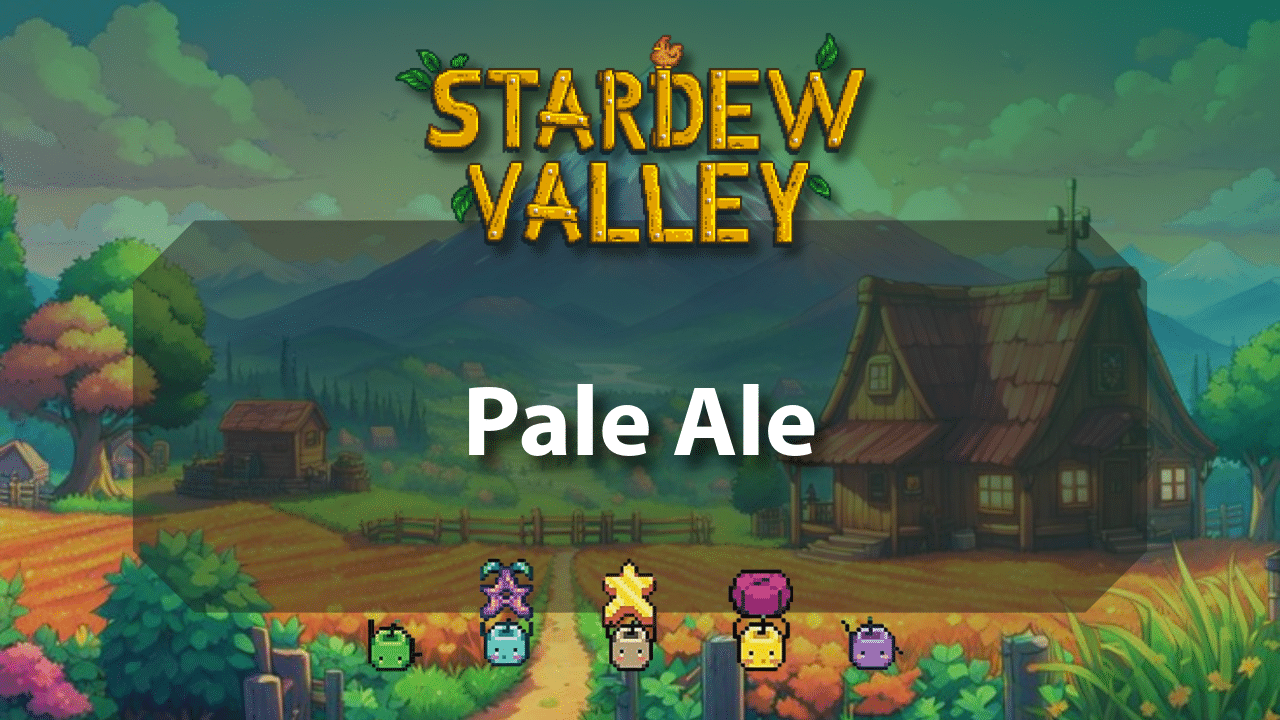
Obtaining Hops Starter
Hops StarterHops Starters are an essential resource in Stardew Valley, allowing players to grow Hops, a key ingredient for brewing Stardew Valley Pale Ale, one of the most profitable artisan goods in the game. These starters can be purchased from multiple sources, with Pierre’s General Store offering them for 60g during Summer and JojaMart selling them for 75g, or 60g with a membership. If players miss their chance to buy them in Summer, they can still obtain them at the Night Market on Winter 16 for 60g.
The Traveling Cart also occasionally stocks Hops Starters, but its prices vary widely between 100g and 1,000g, making it a less reliable option. Once planted, Hops take 11 days to mature and require a trellis, which means careful planning is necessary to ensure that farm layouts remain accessible. After reaching full growth, Hops will continuously produce new crops every day for the rest of the season, making them one of the most efficient crops in terms of yield.
KegWhile Hops can be sold as is, the best use for them is brewing Stardew Valley Pale Ale in a Keg, significantly increasing their value. Pale Ale has a base selling price of 300g, which rises to 420g with the Artisan profession, making it one of the most lucrative alcoholic beverages in the game.
Additionally, Pale Ale can be placed in a Cask inside a fully upgraded farmhouse cellar to improve its quality, with Iridium-quality Pale Ale selling for 600g or 840g with the Artisan profession. Due to its high value and relatively short processing time of 1.5 in-game days per batch, setting up multiple Kegs can create a steady income stream, especially for players who plan their farm around Hops production. Since Hops can only be grown outdoors in Summer, securing Hops Starters in advance is important for maximizing profits.
However, players who want to continue making Pale Ale year-round can take advantage of the Greenhouse to grow Hops in any season, ensuring a constant supply for brewing. Using a Seed Maker to convert harvested Hops into additional Hops Starters can also help expand production without relying on merchants. With the right strategy, players can set up an efficient brewing operation that generates consistent profits, making Stardew Valley Pale Ale one of the best money-making methods available. By carefully planning Hops placement, investing in Kegs, and utilizing the Greenhouse, players can ensure a continuous supply of Hops and maximize their earnings throughout the game.
Planting and Growing Hops
Hops are a valuable and highly productive crop in Stardew Valley, making them an excellent choice for players looking to maximize profits, especially through brewing Stardew Valley Pale Ale. To grow Hops, plant Hops Starters in tilled soil on the farm during Summer, where they will take 11 days to reach maturity. Unlike many crops that must be replanted after each harvest, Hops continue to produce fresh crops every day after their initial growth, allowing for a consistent and efficient yield throughout the season. This makes them one of the best long-term investments for players who want a steady supply of ingredients for brewing or selling raw.
For players who want to produce Hops outside of Summer, they can be grown year-round in the Greenhouse or on Ginger Island, making it possible to maintain a continuous supply even in Winter. This is especially useful for those who want to maximize the production of Stardew Valley Pale Ale, as brewing in Kegs requires a steady flow of ingredients. Since Hops take a relatively long time to mature, using fertilizers to speed up their growth is a great strategy.
Standard Speed-Gro reduces the growth time to 10 days, Deluxe Speed-Gro shortens it to 9 days, and Hyper Speed-Gro further reduces it to 8 days, allowing for an earlier first harvest. Additionally, players who have chosen the Agriculturist profession can decrease growth time by an additional 10%, making it even faster to get Hops ready for harvesting.
Because Hops grow on a trellis, careful planning of farm layout is crucial to prevent movement issues. Trellises act as obstacles, meaning that if crops are placed too closely together without access paths, players may be unable to reach and harvest them efficiently. A recommended strategy is to leave walking space between rows, ensuring that every plant remains accessible throughout the season. This is especially important for large-scale Hops farms, where maximizing efficiency can lead to significant profit gains.
Once harvested, Hops can be sold directly, though their true value lies in their ability to be brewed into Stardew Valley Pale Ale using a Keg. This artisan good sells for a much higher price than raw Hops, making it one of the most profitable brewing options in the game. Since brewing only takes 1.5 in-game days per batch, having a large number of Kegs can turn a Hops farm into a major source of income.
Players who grow Hops in the Greenhouse can ensure a steady year-round supply, maintaining continuous Pale Ale production for maximum profits. By carefully planning planting locations, using growth-boosting fertilizers, and setting up an efficient brewing operation, players can turn Hops into a powerhouse crop that provides a reliable and lucrative income stream throughout their farming journey.
Crafting a Keg
A Keg is an essential piece of equipment in Stardew Valley, allowing players to turn crops into high-value artisan goods, including Stardew Valley Pale Ale, which is one of the most profitable alcoholic beverages in the game. Players can unlock the ability to craft a Keg upon reaching Farming Level 8, at which point the recipe becomes available. Crafting a Keg requires 30 Wood, 1 Oak Resin, 1 Copper Bar, and 1 Iron Bar. Wood is readily available by chopping trees and logs around the farm, making it one of the easier materials to gather.
Copper and Iron Bars can be smelted from Copper and Iron Ore found in the Mines, requiring a Furnace to process them into usable bars. Oak Resin, however, takes time to collect, as it is obtained by placing a Tapper on an Oak Tree and waiting several in-game days for it to produce. Since Oak Resin is also used in other crafting recipes, including Kegs and Deluxe Speed-Gro, it is beneficial to set up multiple Tappers early to maintain a steady supply.
PantryIn addition to crafting, players can also obtain a Keg as a reward for completing the Artisan Bundle in the Pantry section of the Community Center. This provides an early opportunity to acquire a Keg before reaching Farming Level 8, allowing players to begin brewing sooner. Kegs can process a variety of crops into valuable beverages, with Stardew Valley Pale Ale being one of the best choices for profit. Brewing Hops into Pale Ale takes only 1.5 in-game days, making it one of the fastest artisan goods to produce. Given that Hops regrow daily after their initial harvest, players can continuously supply their Kegs with fresh ingredients throughout Summer or year-round in the Greenhouse or on Ginger Island.
Since Kegs can be placed anywhere on the farm, in sheds, or even inside the farmhouse, players looking to maximize profits often set up large-scale brewing operations by crafting and placing multiple Kegs. This allows for mass production of Pale Ale, Wine, and other high-value beverages. The more Kegs a player has, the more efficiently they can process crops into profitable artisan goods, making it a key tool for long-term financial success in Stardew Valley. With proper planning and resource management, investing in Kegs can turn a simple farm into a thriving brewing empire, ensuring a steady and lucrative income stream.
Brewing Pale Ale
To produce Stardew Valley Pale Ale, players must first place a Keg in a suitable location, such as on the farm, inside a shed, or even within the farmhouse for easy access. Kegs are versatile and can be placed almost anywhere, allowing players to organize their brewing operation efficiently. Once the Keg is set up, hold Hops in the hot bar and interact with the Keg to insert them. This begins the brewing process, which takes exactly 2,250 in-game minutes, or 1.5 in-game days, to complete. During this time, the Keg remains occupied and cannot be used for any other purpose.
Once brewing is finished, interacting with the Keg again will collect the freshly made Pale Ale, which is one of the most profitable artisan goods in Stardew Valley. Given that Hops regrow daily once fully matured, players can maintain a continuous supply of ingredients throughout Summer or year-round in the Greenhouse or on Ginger Island. This makes Pale Ale an excellent choice for those looking to maximize profits with an efficient and repeatable process. Since each Keg can only process one item at a time, having multiple Kegs is highly beneficial for large-scale brewing operations, allowing players to produce Pale Ale in bulk.
Strategic placement of Kegs can help streamline production. Many players choose to set up brewing areas inside Sheds to keep the farm organized while maximizing space for crops and animals. Others prefer placing Kegs directly on the farm for quick access during harvests. Regardless of location, keeping a steady supply of Hops and expanding the number of Kegs ensures consistent profits. Because Pale Ale has a relatively short brewing time compared to Wine, it allows for faster turnover and regular income generation.
Beyond its value as a profitable good, Pale Ale can also be aged in Casks within a fully upgraded farmhouse cellar to increase its quality and selling price. Aging Pale Ale to Iridium quality takes time, but it can significantly boost profits for players willing to invest in long-term returns. By efficiently managing Hops production, Keg placement, and brewing schedules, players can create a thriving artisan goods business centered around Stardew Valley Pale Ale, making it one of the best ways to generate income in the game.
Aging Pale Ale in Casks
Aging Stardew Valley Pale Ale in Casks is a crucial step for increasing its quality and maximizing profits. While standard Pale Ale is already a highly profitable artisan good, aging it in Casks raises its value even further, making it one of the best long-term investments for players looking to optimize their farm’s earnings. To begin aging Pale Ale, players must first upgrade their Farmhouse to include a Cellar. This final upgrade, costing 100,000g, not only expands the house but also provides 33 Casks, allowing players to immediately start aging various beverages, including Pale Ale and Wine.
If additional Casks are needed, players can craft them using 20 Wood and 1 Hardwood each. Since space in the Cellar is limited, carefully organizing and expanding the number of Casks can improve efficiency. The aging process follows a specific timeline, gradually increasing the quality of Pale Ale over time. After 9 days, it reaches Silver quality, boosting its value slightly. Allowing it to age for 17 days results in Gold quality, while waiting the full 34 days upgrades it to Iridium quality, which commands the highest selling price.
CaskOnce Pale Ale is placed in a Cask, it will continue aging until it reaches its maximum potential, but players have the option to remove it at any time. However, doing so before it fully ages will reset its progress, meaning it will need to start over if placed back into a Cask. This makes patience a key factor in maximizing profits, as waiting for Iridium quality ensures the highest possible return on investment. Players looking to make the most out of their Cellar space often prioritize aging only the most profitable beverages, such as Pale Ale and high-value Wine, while keeping a steady supply of new products entering the aging cycle.
Since Hops grow daily once mature, and Kegs can continuously brew Stardew Valley Pale Ale in just 1.5 in-game days, maintaining a steady production and aging cycle can lead to massive profits over time. Players can also experiment with different aging strategies, such as staggering batches to create a consistent flow of high-quality Pale Ale ready for sale. With proper management of Kegs, Casks, and farm space, turning a simple Hops farm into a high-profit brewing operation is one of the most rewarding and effective ways to generate income in Stardew Valley.
Selling Prices
Stardew Valley Pale Ale is one of the most profitable artisan goods, offering players a reliable way to generate consistent income. The base selling price of Pale Ale is 300g, making it a valuable product even without further processing. However, aging Pale Ale in Casks increases its quality and boosts its selling price significantly over time. Silver-quality Pale Ale sells for 375g, Gold quality for 450g, and the highest Iridium quality fetches 600g. Since Casks require time to upgrade Pale Ale to higher quality levels—9 days for Silver, 17 days for Gold, and 34 days for Iridium—players must carefully plan their aging process to ensure maximum profits.
For those who have selected the Artisan Profession, which increases the selling price of artisan goods by 40%, the value of Pale Ale rises even further. With this profession, base Pale Ale sells for 420g, Silver-quality for 525g, Gold-quality for 630g, and Iridium-quality for an impressive 840g. Given that Iridium-quality Pale Ale takes 34 in-game days to age fully, it requires patience but offers one of the highest returns on investment. Players looking to maximize their profits should consider focusing on brewing and aging Pale Ale as a long-term strategy, ensuring a continuous supply of freshly brewed batches while older ones mature in Casks.
Since Hops regrow daily after reaching full maturity, and Kegs take only 1.5 in-game days to process Pale Ale, players can establish a steady brewing cycle to keep production running smoothly. Setting up multiple Kegs allows for mass production, ensuring that there is always a surplus of Pale Ale available to be sold or aged. As space in the Cellar is limited, prioritizing high-value items like Pale Ale and Wine for aging can make the most of the available room. Players who want to expand their aging operation can craft additional Casks using 20 Wood and 1 Hardwood each, though careful organization is needed to fit as many as possible within the Cellar’s space.
A well-managed brewing and aging system can turn Pale Ale into one of the most lucrative income sources in Stardew Valley. Whether selling immediately for quick profits or patiently aging batches for maximum returns, investing in Pale Ale production is a smart and effective strategy for building long-term financial success on the farm. By continuously harvesting Hops, efficiently managing Kegs and Casks, and utilizing the Artisan Profession to boost profits, players can turn their farm into a thriving brewing empire centered around Stardew Valley Pale Ale.
Gifting Pale Ale
In Stardew Valley, Pale Ale is a popular gift among most villagers, making it a useful item for increasing friendship. However, not everyone appreciates it, so choosing the right recipients is important. Pam is the only villager who loves Pale Ale, making it one of the best gifts to increase her friendship quickly. Gifting her a Pale Ale grants 80 friendship points, helping players build a stronger relationship with her faster.
While many villagers like Pale Ale, some strongly dislike it. Jas, Leo, Penny, Sebastian, and Vincent all hate receiving Pale Ale as a gift, meaning that giving it to them will result in a loss of friendship points. Since gifting disliked or hated items reduces friendship, it’s best to avoid offering Pale Ale to these characters.
With its high value as both an artisan good and a gift, Pale Ale can be used strategically to strengthen bonds with villagers who appreciate it while also serving as a profitable source of income. Players looking to make the most of their brewing operation can balance selling Pale Ale for gold with gifting it to favored NPCs to maximize relationships in the game.
Pam Is Thirsty Quest
On Summer 14, players receive a letter from Pam requesting a Pale Ale, marking the start of a special quest. Completing this request by giving Pam a Pale Ale rewards 350g and increases friendship with her by one heart. Since Pam loves Pale Ale, players can further boost friendship by gifting her an additional Pale Ale on the same day, effectively increasing her affection more quickly. This makes the quest not only a profitable task but also a great opportunity to strengthen the relationship with Pam.
Managing Pale Ale production efficiently allows players to maximize its benefits. By growing Hops in Summer or year-round in the Greenhouse or on Ginger Island, players can ensure a steady supply. Using Kegs to brew Pale Ale in just 1.5 in-game days keeps production flowing, while aging it in Casks inside the Cellar increases its quality and selling price. Pale Ale can serve as both a highly profitable artisan good and a useful gift for most villagers, aside from a few who dislike it.
Balancing the sale and gifting of Pale Ale allows players to earn gold while also improving relationships with villagers. By strategically brewing, aging, and gifting Pale Ale, players can optimize their farm’s success while also making meaningful connections in Stardew Valley.













